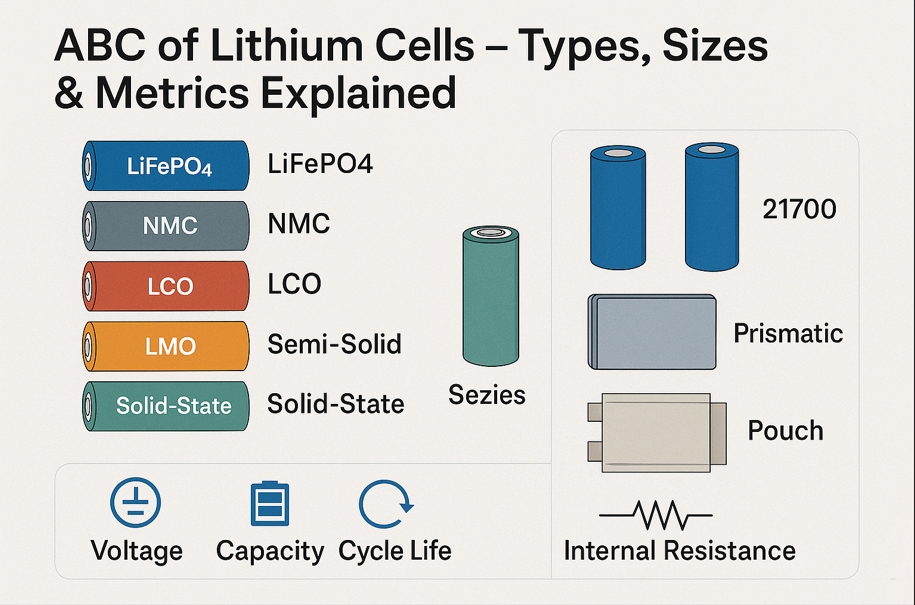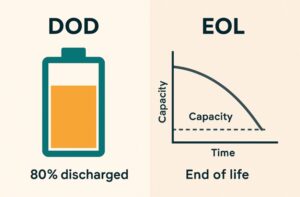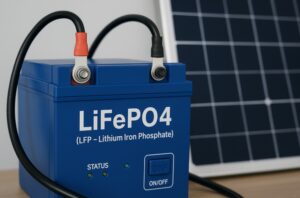- You have no items in your shopping cart
- Subtotal: $0.00

Lithium cells are the beating heart of today’s energy revolution—from solar systems and EVs to power tools and laptops. But not all lithium cells are created equal. Choosing the right one depends on knowing the type, size, model, and how to read key specifications.
Let’s break down the ABC of lithium cells in simple terms so you can make confident and informed choices.
🧪 Types of Lithium Cells
1. LiFePO4 (LFP – Lithium Iron Phosphate)
- ✅ Very safe and stable
- ✅ Long cycle life (~3000–6000)
- ❌ Lower energy density
- 📦 Used in: solar storage, RVs, power banks
2. NMC (Nickel Manganese Cobalt)
- ✅ High energy density
- ❌ Shorter lifespan (~1000–2000 cycles)
- 📦 Used in: EVs, power tools
3. NCA (Nickel Cobalt Aluminum)
- ✅ High capacity and power output
- ❌ Expensive
- 📦 Used in: Tesla EVs and performance battery packs
4. LCO (Lithium Cobalt Oxide)
- ✅ High energy
- ❌ Poor lifespan and safety
- 📦 Used in: Phones, laptops
5. LMO (Lithium Manganese Oxide)
- ✅ Decent safety and performance
- 📦 Used in: Medical devices, some EVs
🧬 Emerging Technologies
6. Semi-Solid Lithium Cells
- ✅ Safer than liquid-electrolyte cells
- ✅ Better energy density than traditional LFP
- 📦 Early-stage adoption in EVs and grid storage
7. Solid-State Lithium Cells
- ✅ Highest energy density, non-flammable
- ✅ Longer lifespan and thermal stability
- ❌ Still under development and expensive
- 📦 Future of EVs and aerospace
📏 Common Cell Formats and Sizes
| Format | Dimensions (mm) | Use Case |
|---|---|---|
| 18650 | 18 x 65 | E-bikes, laptops, power tools |
| 21700 | 21 x 70 | EVs, home batteries |
| 26650 | 26 x 65 | Flashlights, large packs |
| Prismatic | Varies | Solar systems, EV packs |
| Pouch | Thin & flat | Drones, high-density storage |
🔢 What Lithium Cell Model Numbers Mean
Cylindrical cells often have model numbers that reveal their size. Here’s how to decode them:
- First 2 digits = Diameter (in mm)
- Last 3 digits = Length (in tenths of mm)
✅ Examples:
- 18650 = 18mm diameter, 65.0mm length
- 21700 = 21mm diameter, 70.0mm length
- 26650 = 26mm diameter, 65.0mm length
Prismatic and pouch cells don’t follow a universal format—you’ll need to refer to their datasheets for accurate dimensions.

📘 Understanding Lithium Cell Datasheet Metrics
🔋 Nominal Voltage of Lithium Cells
- Typical value: 3.2V (LFP) or 3.6–3.7V (NMC)
- Helps determine the total system voltage
🔋 Capacity (Ah or mAh)
- How much charge the cell can hold
- E.g. 100Ah = 100A for 1 hour
🔁 Cycle Life of Lithium Cells
- Number of charge/discharge cycles before reaching 80% original capacity
- LFP lasts longer than NMC or LCO
🔌 Internal Resistance (IR) of Lithium Cells
- Low IR = less heat, higher efficiency
⚡ Maximum Charge/Discharge Rate
- Given as “C-rate” (1C = current equal to capacity)
- 2C for a 100Ah battery = 200A
🧊 Temperature Range
- Typical range:
- Charging: 0–45°C
- Discharging: -20–60°C
📉 Self-Discharge
- Tells how fast the battery loses charge when not in use
📊 Comparison Table
| Chemistry | Energy Density | Cycle Life | Safety Level | Status |
|---|---|---|---|---|
| LFP | Medium | High | Very High | Fully commercial |
| NMC | High | Medium | Medium | Fully commercial |
| NCA | High | Medium | Medium | Fully commercial |
| LCO | High | Low | Low | Fully commercial |
| LMO | Medium | Medium | Medium | Commercial |
| Semi-Solid | High+ | TBD | High | Pilot/early stage |
| Solid-State | Highest | Longest | Very High | R&D/early pilot stage |
⚠️ Why This All Matters
💡 Ignoring battery specs leads to:
- System underperformance
- Overheating or safety risks
- Reduced battery lifespan
- Poor ROI on your energy investment
✅ Always verify cell quality, read the datasheet, and avoid buying just by price or label.
❓Lithium Cells FAQs
Q1: What is the safest lithium cell for solar use?
Q2: Can I mix different types of lithium cells?
A: No. Mixing chemistries or formats leads to imbalances and can be dangerous.
Q3: What is the best cell format for compact EV packs?
A: 21700 or prismatic cells offer high density in compact space.
Q4: Are solid-state cells available to buy now?
A: Not widely. Most are in R&D or pilot phases with limited commercial availability.
✅ Final Thoughts
Understanding the ABC of lithium cells gives you the power to make smarter decisions when selecting, purchasing, or integrating batteries in any project.
Don’t just ask for “Grade A 100Ah” — ask for:
- Chemistry type
- Cell format
- Datasheet
- Cycle life and safety reports
This small step saves you big money, prevents risks, and builds long-term energy security.




[…] If you import or make 18650 or 21700 cylindrical cells, you certify the cells under IS 16046 Part 1.✅ If you assemble these cells into a battery pack (say, for an electric scooter or energy storage […]
[…] 6000 cycles at 80% DOD […]
[…] Lithium-ion […]
[…] 🔋 a. Lithium-Ion Batteries […]